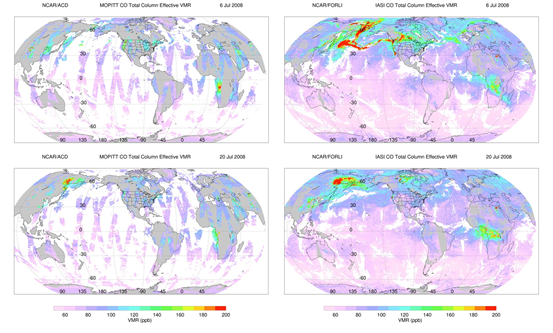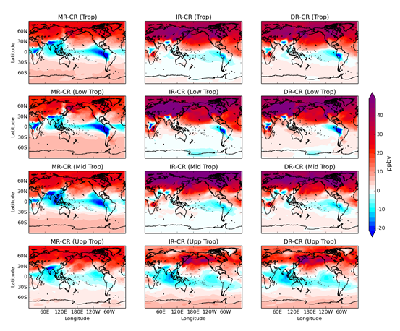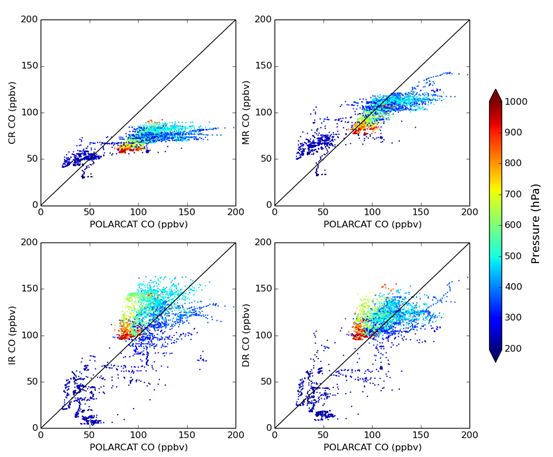Assessing the Impacts of Assimilating IASI and MOPITT CO Retrievals Using CESM/CAM-Chem and DART
The CESM-CAM-Chem/DART data assimilation system is used to investigate and assess the impact of assimilating CO retrieved profiles from two satellite instruments (IASI and MOPITT) on constraining the forecast and analysis of CO in CAM-Chem. The two instruments provide different and complementary capabilities in constraining CO. While the multispectral retrievals from MOPITT have enhanced sensitivity toward the surface and across the main CO source regions, its coverage is relatively limited. On the other hand, retrievals from IASI, while less sensitive to the surface, exhibit both sensitivity to the free troposphere across the globe and broader horizontal coverage (Figure 1).
We carried out 3 sets of experiments (Figure 2) to elucidate the nature of the individual (MOPITT: MR, IASI: IR) and combined (DR) impacts of these retrievals relative to a control run (CR) and to independent CO measurements corresponding to different spatiotemporal scales (TES, POLARCAT (Figure 3), US EPA). The overall evaluation against independent data shows that the chemical data assimilation system performs well in terms of bringing significant improvements in the CO forecasts in CAM-Chem for all experiments. We find that MR mostly constrains the CO fields close to the main anthropogenic and biomass-burning sources while IR constrains mostly CO downwind from the source regions. This work represents our first step towards assimilating multi-species and/or multi-platform retrieval products into CESM-CAM-Chem/DART. Below, we summarize the key insights we found in this work, which may be useful for future chemical DA activities:
- The coverage of IASI versus the sensitivity of MOPITT plays a large role in the nature of the impacts and constraints. The larger coverage of IASI allows better detection of pollution scenes and transported plumes of high CO concentration. The MOPITT multi-spectral retrieval provides enhanced sensitivity at the surface over main CO source regions but has weak sensitivity to the middle troposphere over remote regions. Conversely, IASI does not generally have the strong sensitivity at the surface, but exhibits sensitivity over the free troposphere. These differences in the two instruments are clearly reflected in the DA increments where the CO fields are constrained according to the instruments’ coverage and retrieval sensitivities. The MOPITT increments are mostly in the lower troposphere and close to the major CO sources, while IASI increments are spread more globally and extend throughout the troposphere. Our evaluation with independent measurements indicates that MR does not correct the bias over the Northern Hemisphere as well as IR. IR also shows better performance over anthropogenic source regions (Eastern Asia and CONUS) than MR. However, MR provides equivalent or better results over the NH remote regions (Northern Pacific and Arctic).
- This work points out possible deficiencies in representing CO in CAM-Chem. As pointed out in several sections of this paper, the model emissions are mostly responsible for the systematic CO negative bias in NH. MR corrects the CO fields mostly close to the source and removes the bias in its majority. Because MOPITT has limited coverage compared to IASI, it is however difficult to quantify unequivocally the relative contribution of errors from the sources and sinks of CO to the NH bias. In the tropics, we find that MR degrades CO in remote regions more than IASI, which we attribute to model error propagation. In particular, our analysis suggests the potential role of errors in model vertical transport in moving modeled CO further from observations. We note that detailed investigation and diagnostics over a longer time of integration are needed to elucidate this issue.
- The combined assimilation of MOPITT and IASI retrievals in CAM-Chem (DR) provides synergistic effects. Here, we propose a novel diagnostic to show conditions where the two sources of assimilated information are redundant, complementary or synergistic. On a monthly average timescale, IASI and MOPITT assimilated retrievals share redundant information. It is shown that redundancy is the strongest over Arctic regions where CO lifetime is expected to be longer than in lower latitudes. Synergistic or complementary effects are observed over shorter time and regional scales close to the source regions.

Figure 1. MOPITT (left) and IASI (right) foot-prints and total column effective VMR of CO for the 6th and 20th of July 2008 (first and second row).

Figure 2. Differences between assimilated CO and CO from control run during July 2008: MOPITT assimilation minus Control (MR-CR, first column), IASI assimilation minus Control (IR-CR, second column) and MOPITT + IASI assimilation minus Control (DR-CR, third column). Different layers of the troposphere are diagnosed: full troposphere (Trop, Surface - 200hPa), lower troposphere (Low Trop, Surface – 800hPa), middle troposphere (Mid Trop, 800hPa – 400hPa) and upper troposphere (Upp Trop, 400hPa – 200hPa).

Figure 3. Evaluation of assimilation runs against POLARCAT flights from 30 June 2008 to 14 July 2008. CR, MR, IR and DR cases are shown in the top left, top right, bottom left and bottom right, respectively.
